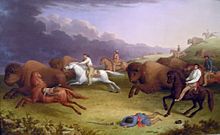- Métis people (United States)
-
For other uses, see Metis (disambiguation).
 Paul Kane's oil painting "Half-Breeds Running Buffalo", depicting a Métis buffalo hunt on the prairies of Dakota in June 1846.
Paul Kane's oil painting "Half-Breeds Running Buffalo", depicting a Métis buffalo hunt on the prairies of Dakota in June 1846.
Métis people are an indigenous people of mixed Native American/First Nations and European ancestry. Some Métis also have African or/and Asian or/and Pacific Islander ancestry; but Métis people with African ancestry are usually considered "Black".
Contemporarily, "Métis" is used to describe any person of mixed Aboriginal North or South American and non-Aboriginal ancestry. Originally, however, the term referred to a specific community of Métis people of mixed Cree or Anishinaabe and Scottish or French ancestry in upper North America, especially the Michif-speaking peoples of the Red River region in what is today modern Manitoba, North Dakota, and Minnesota.[1] The Red River peoples are part of the same ethnic group as many of the Canadian Métis peoples.
The word Métis is pronounced Meh-tee, French for "Mixed-blood."
Contents
Geography
Exploration, settlement, and exploitation of resources by historical French and British fur trading interests across North America gave rise to historical Métis communities through the relationships of male Europeans in the fur trade and Native American women.
Métis people continue to live throughout the United States from the West to East Coasts, with greater or lesser community identity. A strong Prairie Métis identity exists in the "homeland" once known as Rupert's Land, which extends south from Canada into North Dakota, especially the land west of the Red River of the North. The historic Prairie Métis homeland also includes parts of Minnesota, and Wisconsin. Many Métis families continue to show up in the U.S. Census in the historical Métis settlements areas along the Detroit & St. Clair Rivers, Mackinac Island, and Sault Ste. Marie in Michigan, as well as Green Bay in Wisconsin. Métis settlements existed all along the Allegheny and Ohio rivers and their tributaries as evidenced by the French names of the many towns and villages in these areas.
Many, if not most of the descendants of the Métis ceased to exist as a distinct people with the arrival of the English speaking settlers. Initially, the light-haired Métis and, later, with the arrival of the many immigrants from southern Europe, the dark-haired Métis intermarried with these new arrivals. Today,unaware of their heritage, descendants of the Métis in the areas of western Pennsylvania, Ohio, Kentucky, Indiana and Illinois assume they are descended from the more recent immigrants from Europe when, in fact, their European heritage can be traced back hundreds of years.
Current population
Today, in North America, millions of people could, and many thousands do, claim Métis heritage, as they are the product of European and Native American ancestors.[2] Many people of mixed heritage are not aware of the Métis Identity movement within the USA.
Estimated population
An estimated 10,000 self-identified Métis live in North Dakota (mostly in Pembina County, North Dakota although their cultural status is softer than their brethren in Manitoba, Canada). In addition, many members of the Turtle Mountain Band of Chippewa Indians (a federally recognized Tribe) consider themselves Métis. In the Northeast, the Métis Eastern Tribal Indian Society, often referred to as the Métis of Maine, seeks to teach and carry on the North Eastern Woodland Native American heritage to its “mixed blood” (Native and usually European) members of the band. At its Cultural Center located in Dayton, Maine, Métis band elders teach traditional Eastern Woodland Native spiritual and social culture in the Medicine Wheel way, which teaches harmony and respect between the cultures. Membership in this band does not preclude tribal membership in other bands.
Organizations
The United States Metis Nation, Inc. aims "to provide charitable services in support of U.S. Metis Indians – our heritage, culture, and way of life. Metis Nation, Inc. is a "non-federally recognized" tribe.".[3] THe Untied Métis Tribe claims to be "a sovereign Nation as defined by the United Nations Declaration on Indigenous Rights."[4]
See also
- Anglo-Métis
- Métis
- Métis people (Canada)
- Mixed-blood
- Black Indians
- Territorial era of Minnesota
Notes
- ^ Peterson, Jacqueline; Brown, Jennifer S. H. (2001). The new peoples: being and becoming métis in North America. Winnipeg, Manitoba: University of Manitoba Press. p. 5. ISBN 978-0873514088. http://books.google.com/books?id=q8qervZ6nakC.
- ^ Sokolow, Jayme A. (2003). The great encounter: native peoples and European settlers in the Americas. New York: M. E. Sharpe. p. 181. ISBN 978-0-7656-0982-3. http://books.google.com/books?id=ytghV9q6v3cC.
- ^ http://www.usmetis.com/about_us.htm
- ^ http://unitedmetis.org/leaves/index.php/umt-overview
Further reading
- Foster, Harroun Marther. We Know Who We Are: Métis Identity in a Montana Community. University of Oklahoma Press: Norman, 2006.
- Barkwell, Lawrence J., Leah Dorion, and Audreen Hourie. Metis legacy Michif culture, heritage, and folkways. Metis legacy series, v. 2. Saskatoon: Gabriel Dumont Institute, 2006. ISBN 0920915809
- Barkwell, Lawrence J., Leah Dorion and Darren Prefontaine. "Metis Legacy: A Historiography and Annotated Bibliography". Winnipeg: Pemmican Publications Inc. and Saskatoon: Gabriel Dumont Institute, 2001. ISBN 1-894717-03-1
External links
 Métis people
Métis peopleOrganizations History Fur Trade in North America · Red River Rebellion · North-West Rebellion · Southbranch Settlement · in Alberta · Powley rulingSociety in Canada · in the United States · Anglo-Métis · People · Métis Population Betterment Act · List of settlements in Alberta · Metis Child and Family Services Society · Gabriel Dumont InstituteCulture Categories:- Indigenous peoples in the United States
- Métis
Wikimedia Foundation. 2010.
